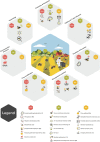Emerging threats and opportunities to managed bee species in European agricultural systems: a horizon scan
- PMID: 37872212
- PMCID: PMC10593766
- DOI: 10.1038/s41598-023-45279-w
Emerging threats and opportunities to managed bee species in European agricultural systems: a horizon scan
Abstract
Managed bee species provide essential pollination services that contribute to food security worldwide. However, managed bees face a diverse array of threats and anticipating these, and potential opportunities to reduce risks, is essential for the sustainable management of pollination services. We conducted a horizon scanning exercise with 20 experts from across Europe to identify emerging threats and opportunities for managed bees in European agricultural systems. An initial 63 issues were identified, and this was shortlisted to 21 issues through the horizon scanning process. These ranged from local landscape-level management to geopolitical issues on a continental and global scale across seven broad themes-Pesticides & pollutants, Technology, Management practices, Predators & parasites, Environmental stressors, Crop modification, and Political & trade influences. While we conducted this horizon scan within a European context, the opportunities and threats identified will likely be relevant to other regions. A renewed research and policy focus, especially on the highest-ranking issues, is required to maximise the value of these opportunities and mitigate threats to maintain sustainable and healthy managed bee pollinators within agricultural systems.
© 2023. Springer Nature Limited.
Conflict of interest statement
The authors declare no competing interests.
Figures
References
-
- Potts, S. G. et al. The Assessment Report on Pollinators, Pollination and Food Production: Summary for Policymakers (Secretariat of the Intergovernmental Science-Policy Platform on Biodiversity and Ecosystem Services, 2016).
-
- Osterman J, Aizen MA, Biesmeijer JC, Bosch J, Howlett BG, Inouye DW, Jung C, Martins DJ, Medel R, Pauw A, Seymour CL. Global trends in the number and diversity of managed pollinator species. Agric. Ecosyst. Environ. 2021;322:107653.
-
- Osterman J, Landaverde-González P, Garratt MP, Gee M, Mandelik Y, Langowska A, Minarro M, Cole LJ, Eeraerts M, Bevk D, Avrech O. On-farm experiences shape farmer knowledge, perceptions of pollinators, and management practices. Global Ecol. Conserv. 2021;32:e01949.
-
- Dicks LV, Breeze TD, Ngo HT, Senapathi D, An J, Aizen MA, Basu P, Buchori D, Galetto L, Garibaldi LA, Gemmill-Herren B. A global-scale expert assessment of drivers and risks associated with pollinator decline. Nat. Ecol. Evol. 2021;5(10):1453–1461. - PubMed
-
- Decourtye A, Alaux C, Le Conte Y, Henry M. Toward the protection of bees and pollination under global change: Present and future perspectives in a challenging applied science. Curr. Opin. Insect Sci. 2019;35:123–131. - PubMed


